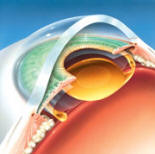4.
I have heard of “phacoemulsification surgery” for
cataracts.
What is it?
"Phacoemulsification"
refers to a modern and advanced technique to remove a cataract.
Basically, the central part of the human lens, called the nucleus, is
relatively hard and cannot be removed by simple suction liking drinking
a Cola through a straw.
Therefore in the past, the surgeon would have to make a large opening
and then "squeeze out" the nucleus. Having a large opening has several
disadvantages. The eye can suddenly bleed profusely during surgery and
become blind. A large opening means a the potential for large amounts of
astigmatism, and it is the rare patient undergoing this old type of
surgery that can have good eyesight without wearing glasses after the
surgery.
In phacomulsification, the surgeon delivers ultrasound energy through a
small probe. The ultrasound energy will convert the hard nucleus into
millions of small particles – thus the term “emulsification”. The entire
surgery can now be carried out with a very small opening. Visual
recovery is relatively faster and patient has less astigmatism. A lot
more patients who have undergone phacoemulsification can walk around
without the use of eyeglasses.
|
|
|
| Through a small incision, use a small probe, The ultrasound energy will convert the hard nucleus into millions of small particles and remove them. Insert an intraocular lens & leave it inside the eye | ||


